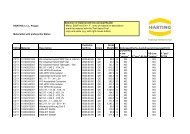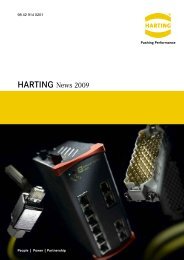Download - Harting
Download - Harting
Download - Harting
Create successful ePaper yourself
Turn your PDF publications into a flip-book with our unique Google optimized e-Paper software.
Tooling<br />
General information<br />
Crimp connection<br />
A perfect crimp connection is gastight, therefore<br />
corrosion free and amounts to a cold weld of the parts<br />
being connected. For this reason, major features in<br />
achieving high quality crimp connections are the<br />
design of the contact crimping parts and of course<br />
the crimping tool itself. Wires to be connected must<br />
be carefully matched with the correct size of crimp<br />
contacts. If these basic requirements are met, users<br />
will be assured of highly reliable connections with low<br />
contact resistance and high resistance to corrosive<br />
attack.<br />
The economic and technical advantages are:<br />
● Constant contact resistance as a result of precisely<br />
repeated crimp connection quality<br />
● Corrosion free connections as a result of cold weld<br />
action<br />
● Pre-preparation of cable forms with crimp contacts<br />
fitted<br />
● Optimum cost cable connection<br />
Requirements for crimp connectors are laid down<br />
in DIN IEC 60 352-2, Amend. 2, as illustrated in the<br />
table.<br />
Tensile strength of crimped connections<br />
Conductor cross-section<br />
Tensile strength<br />
mm² AWG N<br />
0.08<br />
0.12<br />
0.14<br />
0.22<br />
0.25<br />
0.32<br />
0.50<br />
0.75<br />
0.82<br />
1.00<br />
1.30<br />
1.50<br />
2.10<br />
2.50<br />
3.30<br />
4.00<br />
28<br />
26<br />
24<br />
22<br />
20<br />
18<br />
16<br />
14<br />
12<br />
Extract from DIN IEC 60 352-2, Amend. 2, Table IV<br />
11<br />
15<br />
18<br />
28<br />
32<br />
40<br />
60<br />
85<br />
90<br />
108<br />
135<br />
150<br />
200<br />
230<br />
275<br />
310<br />
Pull out force of stranded wire<br />
The main criterion by which to judge the quality of<br />
a crimp connection is the retention force achieved<br />
by the wire conductor in the terminal section of the<br />
contact. DIN IEC 60 352, part 2, defines the extraction<br />
force in relation to the cross-section of the conductor.<br />
When fitted using HARTING crimping tools and<br />
subject to their utilization in an approved manner, our<br />
crimp connectors comply with the required extraction<br />
forces.<br />
Crimp-cross section<br />
HARTING crimp profile<br />
Crimping tools<br />
Crimping tools (hand operated or automatic) are<br />
carefully designed to produce with high pressure<br />
forming parts a symmetrical connection of the crimping<br />
part of the contact and the wire being connected with<br />
the minimum increase in size at the connection point.<br />
The positioner automatically locates the crimp and<br />
wire at the correct point in the tool.<br />
A ratchet in the tool performs 2 functions:<br />
➀ It prevents insertion of the crimp into the tool for<br />
crimping before the jaws are fully open<br />
➁ It prevents the tool being opened before the<br />
crimping action is completed<br />
Identical, perfectly formed, connections can be<br />
produced using this crimping system.<br />
43





